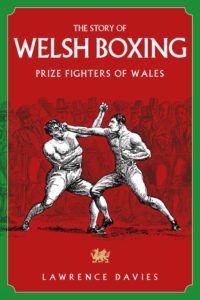Ringside Report Book Review: The Story of Welsh Boxing: Prize Fighters of Wales
[AdSense-A]
When you pick up a boxing book, what do you hope to get out of it? Knowledge? Entertainment? Inspiration? Lawrence Davies’ The Story of Welsh Boxing: Prize Fighters of Wales; Pitch Publishing, accomplishes all those things exponentially. This is truly an amazing book, as boxing is an amazing sport. The best sport to watch, discuss and read about it. One of the many things that separate boxing from most of the sports fray is that it is indeed a worldwide sport. Regardless of how much boxing you think you know, and the amount of time your eyeballs take in the sweet science, there is boxing going on in some crevice of the world that you cannot possibly know about. Not fully anyway. Davies’ book covers a time in boxing that took place before the Queensbury rules, in Wales. A boxing hotbed that still burns with desire until this day.
The book also describes how sword fighting was very prevalent. Many quarrels where decided with the sword instead of the fists at that time.
Lawrence Davies brings to life fighters such as James Figg, Edward Sutton, George Taylor, Jack Broughton, Paddington Jones, Jem Belcher, Edward ‘Ned’ Turner, Jack Scroggins, Jack Randall, Jack Martin, Cyrus Davis, and the like. Each of these fighters is given their due as proud warriors, often fighting well over twenty-five rounds. Among the highlights of the read are the Super Fight between Jem Belcher and Paddington Jones, and the impeccable details of Ned Turner’s career. Turner is depicted as an enormous heroic figure with a fantastic, yet sympatric boxing career.
Lawrence Davies is revered for his researching prowess, and that skill comes to fruition with vivid detail. He and his team try and answer the daunting question of when the story of Welsh boxing began. Davies answers this question as best as he could, considering that the dedication of research for boxing in Wales at that time was very bleak. Lawrence does a great job with what he had to work with, and his description of the fights he was able to uncover is tremendous. The action is described in a fast-paced, often grotesque way, where the punches landed, and punishment delivered comes right off the page and jumps directly into your senses and soul.
Another amazing aspect of this read is how much in common boxing in the modern era had with the 18th and 19th centuries. During this read, boxing fans will identify such commonalities as fighters with a more ground-breaking, scientific approach, fighters using their height and reach advantages pragmatically, fighters who took training lightly and partied way too much, the dynamic of fighters aging, the dynamic of the trilogy, and how fighters became great friends after fierce battles. It was all there then, as it is now.
You will also read how fighters called each other out with newspaper ads. Indeed, the print news was used for fighters to issue challenges to other fighters, and those fighters would reply to said challenge with a written reply. Can anyone say, twitter? One significant contrast to these times that you will read about is the business part of boxing. Absent is the promoter with the big bucks, and instead, you will learn about how boxers had to dig into their own pocket, and/or depend on the generosity of others to make a fight happen.
While the action in The Story of Welsh Boxing is fast and fierce; you learn about how there was sometimes patchwork surgery on the flesh of fighters so they can continue on, the pages are meant to absorb, not breeze by. Included are informative footnotes for the reader to digest. Indeed, as your heart races at an exhilarating rate from the described action, you are required to take the time and learn. No doubt a win, win.
If you want to be on the winning side of history, and raise your knowledge of boxing, this book is definitely worth your time.
You can purchase the book by clicking HERE.
[si-contact-form form=’2′]


